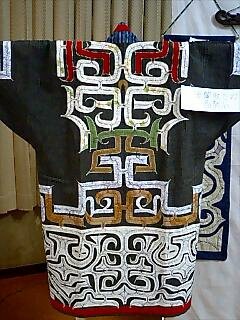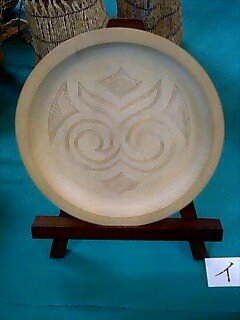A Bit of Ainu Culture
Some facts about the Ainu people:
The Ainu are the people native to the Japanese islands.
There are only about 24,000 Ainu left in Japan, spread out in different areas around Hokkaido.
Two-thirds of them live in the Iburi and Hidaka regions of Hokkaido (south central).
Their language and culture was rejected by the Japanese government, and they were forced to learn how to speak Japanese and were not allowed to continue their traditions and rituals.
There are very few Ainu alive today who can actually speak the Ainu language.
Ainu groups like the one based in Horobetsu organize Ainu language classes, sewing classes, lectures and other events to promote Ainu culture and encourage understanding between Japanese and Ainu. (Like the event of this evening.)
To continue...
At the Tetsunan Fureai community center, a display of traditional Ainu weaving and other Ainu items was also going on.
 The patterns are designed to be mirror images both horizontally and vertically.
The patterns are designed to be mirror images both horizontally and vertically. There are a lot of "pointy" parts to the patterns. These points serve as talismans to ward off evil. There are also a lot of owl images in these patterns, as owls are considered to be guardian spirits.
There are a lot of "pointy" parts to the patterns. These points serve as talismans to ward off evil. There are also a lot of owl images in these patterns, as owls are considered to be guardian spirits. A restoration of Muroran-area Ainu patterned clothing.
A restoration of Muroran-area Ainu patterned clothing. A display of other various items: plates, knives, a bow, ceremonial items, etc.
A display of other various items: plates, knives, a bow, ceremonial items, etc. See the owl?
See the owl? These are for scooping an Ainu alcohol used in religious ceremonies. They function as tongues, and the drops of alcohol carry your words (actually become the words themselves) to the deities for them to hear.
These are for scooping an Ainu alcohol used in religious ceremonies. They function as tongues, and the drops of alcohol carry your words (actually become the words themselves) to the deities for them to hear.
The majority of place names in Japan are names that were adapted from the Ainu names into Japanese. For example, the city of Noboribetsu is an adaptation of the Ainu word Nuppuripet, which means "muddy river". The "pet" part of the name means "river", and this was adapted into the Japanese "betsu". You will see "betsu" in a lot of place names in Hokkaido, as there are a lot of rivers. Monbetsu, Washibetsu, Horobetsu, Noboribetsu, Memanbetsu, etc. While a lot of place names in Hokkaido use kanji, these were mostly chosen to fit the Japanization of the original Ainu place names. So even though Noboribetsu is written with the characters for "to climb" and "to separate", the characters don't really mean anything.
Muroran is an adaptation of the Ainu word "mo-ru-e-ran-i", which means "the place at the bottom of a sloped path". This was Japanized into "Mororan", and then into the "Muroran" which is in current use.
I also learned that orcas are the most respected spirits in nature, according to the Ainu. I also learned that you can see orcas in the sea outside of Muroran. COOL! There was a little more explanation of the Ainu spiritual view, but I couldn't really follow it at all. I did pick out that it is a shamanistic religion, though.
I talk like I know what I'm talking about, but I'm sure that there are a lot of things I'm not picking up on yet. I welcome the opportunity to learn more, though.
After the presentation was finished, there was a little party for anyone who wanted to attend. This meant more beer, but also free food, and a chance to talk with some of the group members. After the party was over, Ms. Fujibe, a part-time English teacher at Starfish High and the person who informed me about the event (she is really involved with the activities that the group puts on), gave me a ride back home.
After which I promptly went to bed.



0 Comments:
Post a Comment
<< Home